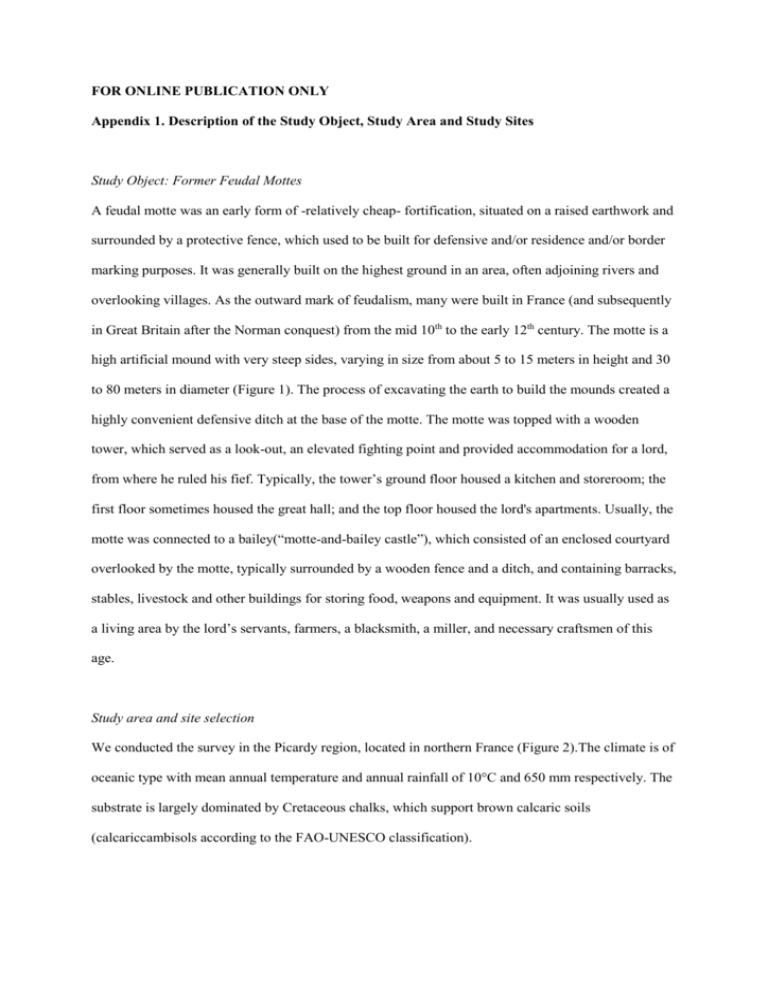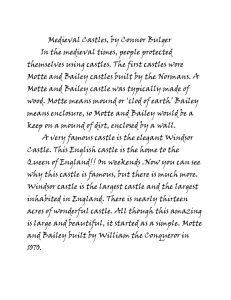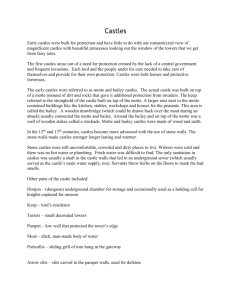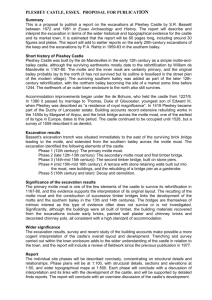FOR ONLINE PUBLICATION ONLY Appendix 1. Description of the
advertisement

FOR ONLINE PUBLICATION ONLY Appendix 1. Description of the Study Object, Study Area and Study Sites Study Object: Former Feudal Mottes A feudal motte was an early form of -relatively cheap- fortification, situated on a raised earthwork and surrounded by a protective fence, which used to be built for defensive and/or residence and/or border marking purposes. It was generally built on the highest ground in an area, often adjoining rivers and overlooking villages. As the outward mark of feudalism, many were built in France (and subsequently in Great Britain after the Norman conquest) from the mid 10th to the early 12th century. The motte is a high artificial mound with very steep sides, varying in size from about 5 to 15 meters in height and 30 to 80 meters in diameter (Figure 1). The process of excavating the earth to build the mounds created a highly convenient defensive ditch at the base of the motte. The motte was topped with a wooden tower, which served as a look-out, an elevated fighting point and provided accommodation for a lord, from where he ruled his fief. Typically, the tower’s ground floor housed a kitchen and storeroom; the first floor sometimes housed the great hall; and the top floor housed the lord's apartments. Usually, the motte was connected to a bailey(“motte-and-bailey castle”), which consisted of an enclosed courtyard overlooked by the motte, typically surrounded by a wooden fence and a ditch, and containing barracks, stables, livestock and other buildings for storing food, weapons and equipment. It was usually used as a living area by the lord’s servants, farmers, a blacksmith, a miller, and necessary craftsmen of this age. Study area and site selection We conducted the survey in the Picardy region, located in northern France (Figure 2).The climate is of oceanic type with mean annual temperature and annual rainfall of 10°C and 650 mm respectively. The substrate is largely dominated by Cretaceous chalks, which support brown calcaric soils (calcariccambisols according to the FAO-UNESCO classification). Figure 1. Reconstitution of a motte-and-bailey castle. Drawn by Silvère Decocq. For the purpose of this study only mottes currently located in ancient forests(that is, forests that have continuously existed since the end of the 18th century, whether they are managed or not) were retained as they are taken away from current human disturbances (except forest management). On the basis of archaeological databases, we first selected a number of candidate mottes. A field survey was then implemented for the final selection of sites. We excluded sites for which there was evidence for recent disturbances (for example, a clearcut), those that were partly deforested or located at the forest edge, and those located in a forest patch too small to allow us to set a control plot free from edge effect and/or past human settlement influence. A total of 19 mottes were finally selected (Figure 2). Eachmotteconsisted of an artificial mound built with local material (that is, a mixture of chalk, flints, clay and loess), often surrounded by a ditch (Figure 3). This artificial substrate supported a thin organic layer (Figure 4a). Paired control sites were selected in the immediate vicinity (200 m on average) of the motte, in a plausibly formerly unoccupied site (that is, without archaeological artefact) with “natural” soil conditions (calcariccambisol; Figure 4b) and sharing the same canopy cover conditions as the motte (>70%). The control site was thus sufficiently distant from the motte (and from the former bailey whenever it was existing) to avoid the formerly inhabited area, but not too far to avoid formerly cultivated areas; it is thus likely that control sites were located in former marginal lands. Each control areawasprobably affected by past human disturbance at the time the neighboringmotte was occupied, but we assume that the disturbance intensity was disproportionately lower. Figure 2. Location of thenineteen study sitesin the Picardy region (N France). Each site consists in a single patch of ancient forest in which a former feudal motte was retrieved, close to which a control site could be set. Map drawn by E. Gallet-Moron, Edysan FRE 3498 CNRS-UPJV. Figure 3. Today’s aspect of a former feudal motte in a forest.Topographic anomalies on an otherwise flat terrain make it possible to relocate the motte (mound of earth on the left, surrounded by a ditch remain) and, whenever existing, the former bailey. Photo by Guillaume Decocq, Edysan FRE 3498 CNRS-UPJV. The mottes included in this study were built between the end of the 10th century and the end of the 11th century. They were continuously occupied until reclamation, during the Hundred Years War (late 14th - beginning 15th century). It is likely that both mottes and control sites became progressively afforested in the course of the 15th century, because the country was undergoinga strong depopulation due to the combined effect of wars, plague epidemics and famines, which was associated withan episode of forest extension. It is also likely that these sites remain continuously forested until nowadays, because they appear as such on both the oldest available map (Cassini map; second half of the 18th century) and the map corresponding to the “forest minimum” (first half of the 19th century). Figure 4. Typical soil profiles of the study sites. (a) Mottes: thin Anthrosol developed on an artificial substrate composedby chalk, flints, clay and lœss that have been locally excavated. (b) Control sites: calcariccambisol developed on the natural substrate which consistsin Cretaceous chalk covered by Quaternary lœss. Photos by Guillaume Decocq (a) and HélèneHoren (b), Edysan FRE 3498 CNRS-UPJV.








